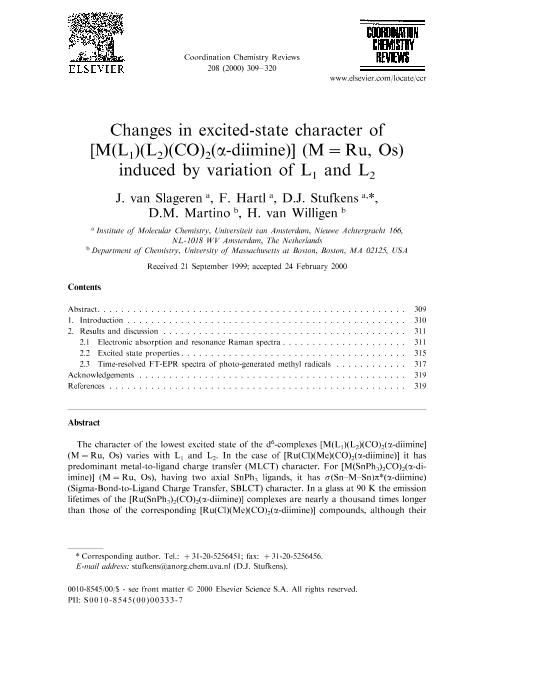Artículo
Changes in excited-state character of M(L1)(L2)(CO)2(α-diimine) (M=Ru, Os) induced by variation of L1 and L2
Fecha de publicación:
12/2000
Editorial:
Elsevier Science Sa
Revista:
Coordination Chemistry Reviews
ISSN:
0010-8545
Idioma:
Inglés
Tipo de recurso:
Artículo publicado
Clasificación temática:
Resumen
The character of the lowest excited state of the d6-complexes [M(L1)(L2)(CO)2(α-diimine] (M=Ru, Os) varies with L1 and L2. In the case of [Ru(Cl)(Me)(CO)2(α-diimine)] it has predominant metal-to-ligand charge transfer (MLCT) character. For [M(SnPh3)2CO)2(α-diimine)] (M=Ru, Os), having two axial SnPh3 ligands, it has σ(SnMSn)π*(α-diimine) (Sigma-Bond-to-Ligand Charge Transfer, SBLCT) character. In a glass at 90 K the emission lifetimes of the [Ru(SnPh3)2(CO)2(α-diimine)] complexes are nearly a thousand times longer than those of the corresponding [Ru(Cl)(Me)(CO)2(α-diimine)] compounds, although their emission energies are very similar. In fact, these lifetimes are extremely long (e.g. τ=1070 μs for [Ru(SnPh3)2(CO)2(4,4′-dimethyl-2,2′-bipyridine)]) for a CT state. Although replacement of Ru by Os decreases both the emission energy and lifetime of complexes such as [M(bpy)3]2+ (M=Ru, Os), only the emission lifetime decreases in the case of the [M(SnPh3)2CO)2(α-diimine)] compounds. The latter effect is due to the increase of spin-orbit coupling (SOC), the influence of which could thus be studied without taking into account any energy-gap-law effect. Preliminary photophysical data are presented for [Pt(SnPh3)2(Me)2(i-Pr-DAB)], which has very similar excited state properties as the corresponding Ru- and Os-complexes. Replacement of a SnPh3 ligand by a methyl group to give [Ru(Me)(SnPh3)(CO)2(i-Pr-DAB)] increases the photoreactivity of the complex. The weaker RuMe bond is broken homolytically and the formation of methyl radicals was studied in detail with FT-EPR spectroscopy.
Archivos asociados
Licencia
Identificadores
Colecciones
Articulos(INTEC)
Articulos de INST.DE DES.TECNOL.PARA LA IND.QUIMICA (I)
Articulos de INST.DE DES.TECNOL.PARA LA IND.QUIMICA (I)
Citación
van Slageren, J.; Hartl, F.; Stufkens, D.J.; Martino, Debora Marcela; van Willigen, H.; Changes in excited-state character of M(L1)(L2)(CO)2(α-diimine) (M=Ru, Os) induced by variation of L1 and L2; Elsevier Science Sa; Coordination Chemistry Reviews; 208; 12-2000; 309-320
Compartir
Altmétricas




